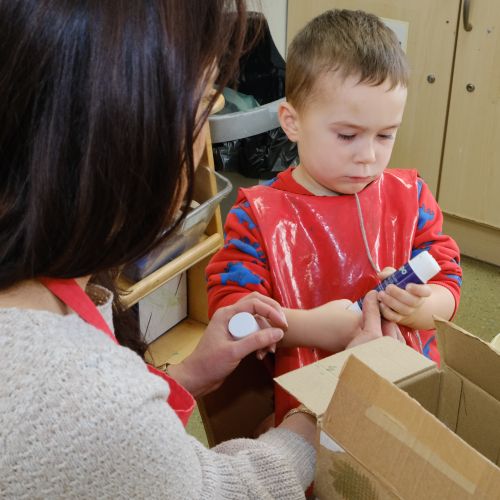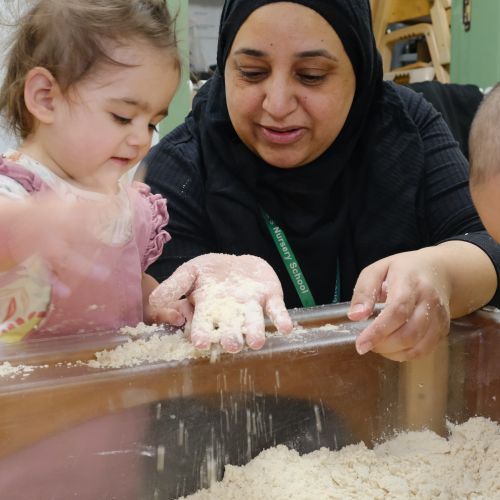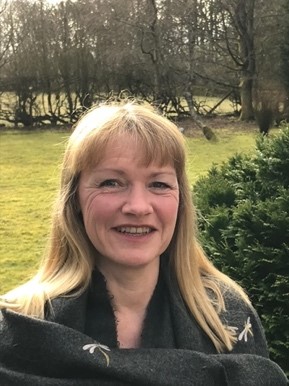Blog
Early Years Supermodels
Ok, so early years practitioners may not necessarily be well known for their haute couture and strutting their stuff on the catwalk. However, modelling is an extremely important professional skill. The setting we work in is our catwalk. Our audience can be varied with colleagues, parents, observers, and inspectors wanting to know how we carry our work. Yet, it is the children who watch us every day.
Modelling is seen as an important teaching skill in the early years. Practitioners need to be able to demonstrate to children how to do things well. If you were to visit the Early Years Evidence Store (EEF, 2023) you would find that modelling is an approach identified for supporting both Personal, Social and Emotional Development, and Communication and Language. In the latest
theme of Self-Regulation and Executive Function the use of both explicit teaching and modelling are referred to as approaches used to support children. This modelling approach is about making deliberate decisions about the positive use of language and behaviours that we want to make evident to children. It is explicit and involves showing children alongside explanation.

Practitioner engaging with a child.

Practitioner engaging with a child.
Whilst I wholeheartedly agree that this role as a model is important, I think we need to reflect upon our role far more deeply if we want to be supermodels for the children in our care. Good role modelling is about more than demonstrating aspects of learning. It involves our whole selves and who we are with the children on a minute-to-minute basis. For example, I would
suggest that the impact of co-regulation is diminished if children observe adult’s who are struggling to manage their own emotions as they go about their work.
We only need to observe children role playing to see the impact that the adults around them are having. I have often felt a little uncomfortable about my own behaviours and mannerisms when I have watched them playing schools. We see them using the words, phrases, gestures and expressions of adults that they know well. We see them creating similar environments and selecting similar resources to the ones we offer them. We can often see the moods and reactions of familiar adults in the way they play out a scenario.
It is essential to realise that alongside the content that we choose to communicate to children, they are also constantly learning from exposure to the world around them. This learning can be for the better or for worse. If we want to have a positive impact it is imperative for us to consider what version of ourselves we are presenting to them. Professor Helen Hedges (2022, p97) looked at this form of learning from the child’s point of view and has framed seven fundamental inquiry questions that she suggests children are asking themselves when building their personal, learner and cultural identities. One of those fundamental questions is ‘What do intelligent, responsible, and caring adults do?’. Wow, what a responsibility.
There are many things that may impact on a practitioner’s ability to be a successful early years supermodel. These could include personal circumstances, personal experience, the setting’s culture, team dynamics, relationships with adults and children, how effectively staff well-being is monitored, intrinsic and extrinsic expectations. None of us operate in isolation and no one gets is right all of the time. We need to learn to ask for support when the going gets tough and there are times when getting it wrong provides an excellent opportunity to support learning for both adults and children.
In my experience, continued professional development tends to focus on understanding curriculum content, pedagogy, and managing aspects of provision. It is my belief that taking a broader view of professional development which includes attention on how to develop personal effectiveness would be very supportive for practitioners and, in turn, would result in stronger learning opportunities for children. This might involve some direct training but would probably require the setting to look at providing more regular opportunities for reflection, challenge and support. Coaching could be a useful tool in personal development and a recent study (Sims and Fletcher-Wood, 2020, p12) found that professional development based on coaching shows correlations with positive pupil outcomes.
In conclusion, modelling is a very useful teaching skill that all practitioners can learn to use but it is important to be aware that children draw from more than the deliberate actions that we put into our teaching. We want to support them to become the best versions of themselves by presenting the best versions of ourselves when we are at work. To be an early years supermodel it is not enough to live by the old phrase ‘do as I say’ because children really do ‘do as we do’.
References
Education Endowment Foundation. (2023) Early Years Evidence Store. (Accessed Online 07/05/24) https://educationendowmentfoundation.org.uk/support-for-schools/evidence-for-the-early-years/early-years-evidence-store
Hedges, H. (2022) Children’s Interests, Inquiries and Identities: Curriculum. Pedagogy, Learning and Outcomes in the Early Years. Oxford: Routledge.
Sims, S., and Fletcher-Wood, H. (2020). Identifying the characteristics of effective teacher professional development: a critical review. School Effectiveness and School Improvement, 1 - 17.https://doi.org/10.1080/09243453.2020.1772841.
 |
Leslie Patterson
|
